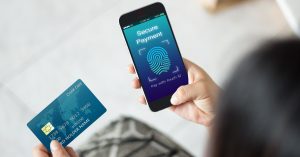Estimated reading time: 3 minutes
Data breaches and full network hacks are a touchy subject for enterprises everywhere. When passwords aren’t enough to protect valuable information, this leaves businesses struggling to protect employees and their customers’ private and financial information. Such occurrences of this thievery are normalized, unfortunately, but still very sensitive for the parties involved. In the case of both large and small banks are reinstating new methods of authentication where it’s necessary. The power of biometrics brings sturdier authentication processes, when employees are falling victim to such vicious attacks.  Biometrics creates a painless experience for consumers and bankers, alike. Say goodbye to the pages upon pages of checking boxes and dotting I’s, for the authentication process will be simpler.
Biometrics creates a painless experience for consumers and bankers, alike. Say goodbye to the pages upon pages of checking boxes and dotting I’s, for the authentication process will be simpler.
What is Biometrics Exactly?
Biometric systems capture data and then typically encrypt them, thereafter. That information is then stored so that upon login, the system can compare that data with other data to help identify a user more fluently. If the user input matches the stored data, then the user will be granted access to whichever application they are trying to use. Some challenges of utilizing biometrics security tactics within a business are a stronger and more convenient strategy overall. It offers more secured regulatory requirements and an expanded choice in authentication steps is encouraged. Consumer trust is ultimately heightened, providing users with a seamlessly easier user experience. This strategy lessens the chance of fraud within internal and external activities as well.
| Advantages of Biometrics | Disadvantages of Biometrics |
| Hard to fake ownership | Costly Tactic |
| Non-transferrable information | False rejects and accepts can take place |
| Ease-of-use | Hacks can still take place |
| Hard to steal account information | If a user injures their hand or voice, the authentication is less likely to register. |
Next Level Authentication
The use of biological characteristics and tendencies to verify the identity of a user to access an account has proven itself to upgrade time after time. From iris and facial recognition, fingerprint scans, and voice identification, we can only go up from here. These modes of validation are becoming increasingly more common within corporate settings, through public buildings’ security systems, electronics, and even Point-of-Sale software applications.
It’s much more difficult for fraudsters to access accounts through systems that require such biometric authentication that requires such qualifications, because there’s no getting past that. Many of these features are proving to be increasingly more capable of blocking hackers.
Biometric Banks
Banks are taking a step back from stored data for verification and are taking biometrics with cloud identity-as-a-service technology. That type of authentication is accomplished in just seconds. Many banks have online and mobile banking setup for their customers, so they can access their checking/savings accounts, pay bills and setup alerts if necessary. Such apps will have fingerprint or Touch ID logins to access that data. There you have biometrics at play. 
Technically speaking, reciting one’s 4-digit PIN aloud over the phone with a personal baker is pretty common. It’s not ideal, however, because fraudsters and cyber-hackers could be lurking around the corner, no matter how long or quiet the nature of the phone call could be.
Businesses Beware
There is some governance in biometrics, so banks should be mindful of the repercussions, if they aren’t able to collect the information correctly. The Biometric Information Privacy Act (BIPA) oversees the collection, retention, disclosure, storage, transfer, and detention of biometric data, including the previously mentioned qualifications. BIPA requires that companies who collect or possess biometric data are to develop a written policy, which should be made available to the public.
Businesses must provide customers with a written notice to report the means of collection, the purpose for which it was collected, and the length of time the data will be collected, stored, and utilized. If a violation was recorded and it was found to be unintentional a fine of $1,000 can be charged. If the act were intentional, the fine could potentially jump to $5,000.
We’re venturing into doing away with traditional passwords alone, as a means of protecting accounts. It’s no lie that a zero trust model has been influenced in today’s daily workflow. The idea that according to the principle of maintaining strict access controls and limited trust by default defines how far we’ve come. Whether it’s two-factor or multi-factor authentication that is placed into the equation, we are more comfortable with the added security measures arranged into industry applications. Bankers and Financial Institutions, alike, should take notes to benefit not only their customer’s private information, but their credibility as an establishment.

